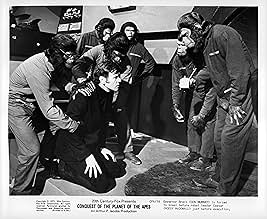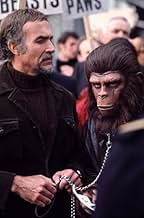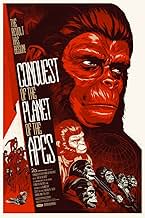En un mundo futurista que ha adoptado la esclavitud de los simios, César, el hijo de los difuntos simios Zira y Cornelius, reaparece tras casi veinte años de esconderse de las autoridades, y... Leer todoEn un mundo futurista que ha adoptado la esclavitud de los simios, César, el hijo de los difuntos simios Zira y Cornelius, reaparece tras casi veinte años de esconderse de las autoridades, y prepara una revuelta contra la humanidad.En un mundo futurista que ha adoptado la esclavitud de los simios, César, el hijo de los difuntos simios Zira y Cornelius, reaparece tras casi veinte años de esconderse de las autoridades, y prepara una revuelta contra la humanidad.
- Dirección
- Guión
- Reparto principal
- Premios
- 1 nominación en total
Reseñas destacadas
It's been a generation since Roddy McDowall and Kim Hunter were killed by the forces of fear and in the interim their son also played by Roddy McDowall has grown up under the kind care of Ricardo Montalban, a circus owner. In the interim a plague came to earth and wiped out all the dogs and cats in the world, so people starting to take apes as pets. It wasn't long before the more avaricious of human kind saw the possibility in exploiting the apes as a new slave class.
Those avaricious ones are symbolized by Don Murray who is the governor of I presume California. Note how he and all the folks like him and who work for him are dressed in black to symbolize both villainy and fascism. No subtleties in this film. Not all feel like Murray and one who doesn't is an aide played by Hari Rhodes. Why he feels that way about exploiting anyone is rather obvious when you see the movie.
Conquest Of The Planet Of The Apes may not be subtle, but it is very effective in putting its point of view across. It holds up very well for today's audience because its message is very relevant.
Conquest for the Planet of the Apes, the fourth in the series, covers the 'pre-history' of the first movie, where the apes first start to gain some ascendancy in the world of humans. And like the first movie (and to a lesser degree the second) it actually strives to make a social statement AND does a decent job. Parallels are drawn between the apes struggle against slavery to humans and the struggle for civil rights of black people in America with the ape riot scene intended to imitate a famous riot in the sixties. The point is well made considering the censorship restrictions on violence and the touchy nature of the underlying subject matter - a topic well discussed today but not overtly talked about in 1972. The result is daring, well-made (the riot is stunning) and well-meaning, but sometimes a little clumsy.
Some fairly elementary things are overlooked, as well, such as the fact that in the first movie the apes were evolved by 2000 years thus excusing their very human bearing, but here, in the 'future' of 1991, they are just supposed to be apes with clothes on...doesn't quite work.
All in all, though, an entertaining film and a good showcase for Roddy McDowall's real acting abilities. 7 out of 10.
A very Dystopian, bleak future is what this film has to offer. An authoritarian Governor in the year 1991 has made apes into slaves and brutality between apes and man is a common everyday occurrence.
After torturing the future leader of the apes, Cesar leads a revolt against his human captors and wins out in the end.
Starring: Roddy McDowall, Don Murray, Ricardo Montalban, Hari Rhodes and Natalie Trundy.
Screenwriter Paul Dehn wrote the film incorporating references to the racial conflicts in North America during the early 1970s. This is evident, as the theme is about apes becoming servants and slaves. Now, it is not really explained how the chimpanzees go from being normal chimps to the more humanoid apes we see in this film. But I guess we are supposed to just pretend these are all real chimps.
The message is a bit strong, but maybe made more sense at the time. Today it seems like they tried too hard and it almost seems silly.
¿Sabías que...?
- CuriosidadesAn original script draft showed more of the rapid evolution of the apes from primitive to intelligent and showed the progression of apes from pets to slaves.
- PifiasIn less than 20 years since Huida del planeta de los simios (1971), chimpanzees, gorillas and orangutans have evolved to a perfectly humanoid form, a progression that would take thousands of years, not just one generation.
- Citas
MacDonald: Caesar... Caesar! This is not how it was meant to be.
Caesar: In your view or mine?
MacDonald: Violence prolongs hate, hate prolongs violence. By what right are you spilling blood?
Caesar: By the slave's right to punish his persecutor.
MacDonald: I, a descendant of slaves, am asking you to show humanity.
Caesar: But, I was not born human.
MacDonald: I know. The child of the evolved apes.
Caesar: Whose children shall rule the earth.
MacDonald: For better or for worse?
Caesar: Do you think it could be worse?
MacDonald: Do you think this riot will win freedom for all your people? By tomorrow...
Caesar: By tomorrow it will be too late. Why a tiny, mindless insect like the emperor moth can communicate with another over a distance of 80 miles...
MacDonald: An emperor ape might do slightly better?
Caesar: Slightly? What you have seen here today, apes on the 5 continents will be imitating tomorrow.
MacDonald: With knives against guns? With kerosene cans against flamethrowers?
Caesar: Where there is fire, there is smoke. And in that smoke, from this day forward, my people will crouch and conspire and plot and plan for the inevitable day of Man's downfall - the day when he finally and self-destructively turns his weapons against his own kind. The day of the writing in the sky, when your cities lie buried under radioactive rubble! When the sea is a dead sea, and the land is a wasteland out of which I will lead my people from their captivity! And we will build our own cities in which there will be no place for humans except to serve our ends! And we shall found our own armies, our own religion, our own dynasty! And that day is upon you... now!
- Créditos adicionalesThe 20th Century-Fox logo does not appear on this film.
- Versiones alternativasThe film was cut for violence in the final battle scene by the US distributor for a 'PG' rating. Similarly the BBFC (UK) cut the electrical torture of Caesar, and closeup scenes of violence from the killing of the guards and the climactic battle for an 'AA' cinema rating. Video releases were classified as '15' (now '12' for the DVD) and all prints feature the edited U.S version.
- ConexionesFeatured in Batalla por el planeta de los simios (1973)
Selecciones populares
Detalles
- Fecha de lanzamiento
- País de origen
- Sitios oficiales
- Idioma
- Títulos en diferentes países
- Conquest of the Planet of the Apes
- Localizaciones del rodaje
- University of California, Irvine, California, Estados Unidos(city exteriors)
- Empresas productoras
- Ver más compañías en los créditos en IMDbPro
Taquilla
- Presupuesto
- 1.700.000 US$ (estimación)
- Recaudación en Estados Unidos y Canadá
- 9.043.472 US$
- Recaudación en todo el mundo
- 9.043.472 US$
- Duración1 hora 28 minutos
- Color
- Relación de aspecto
- 2.39 : 1
Contribuir a esta página




































